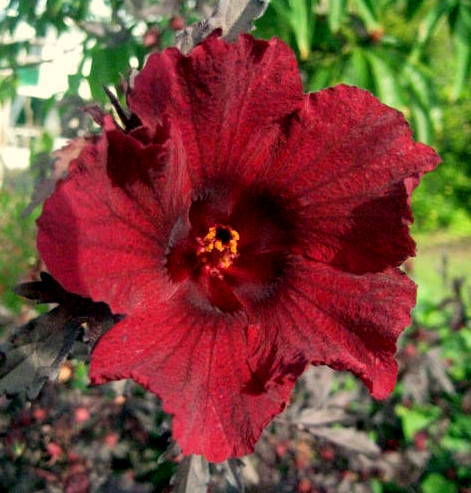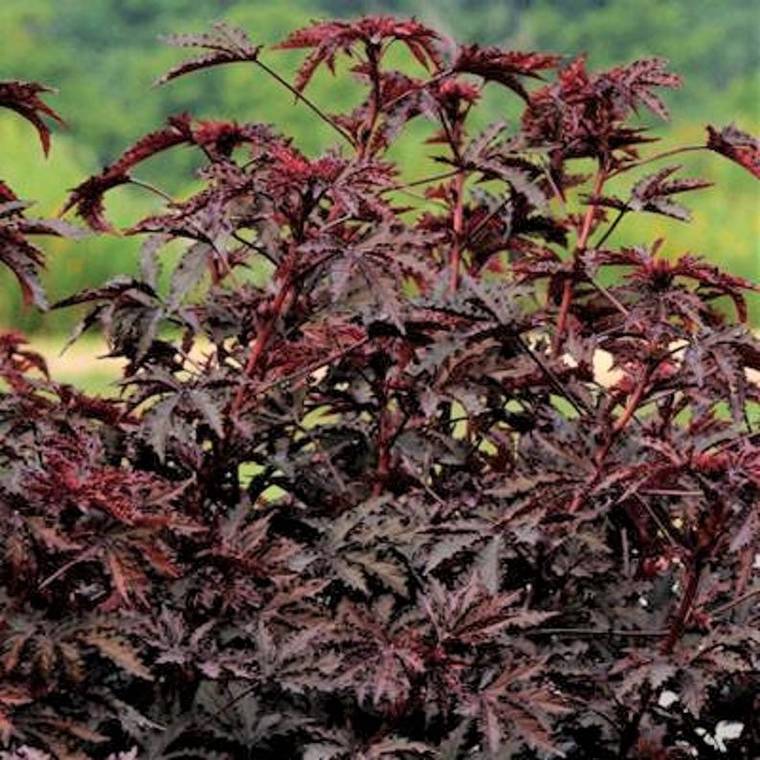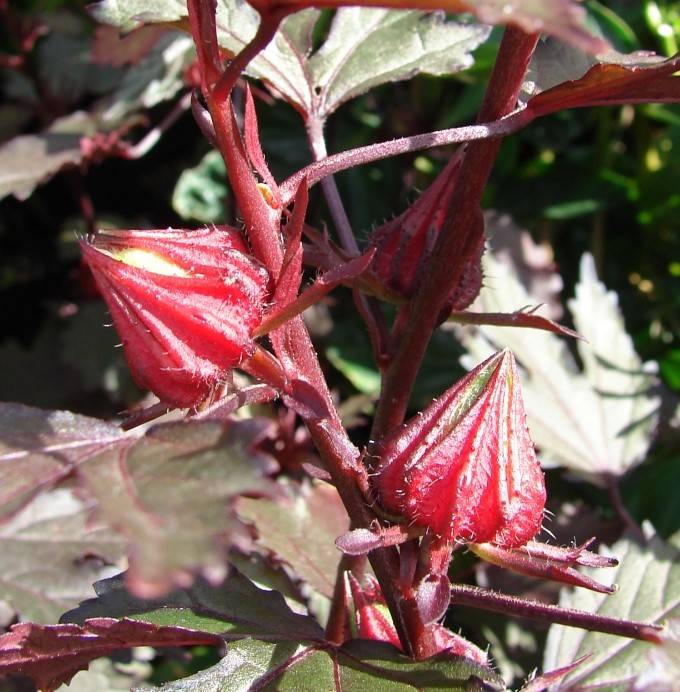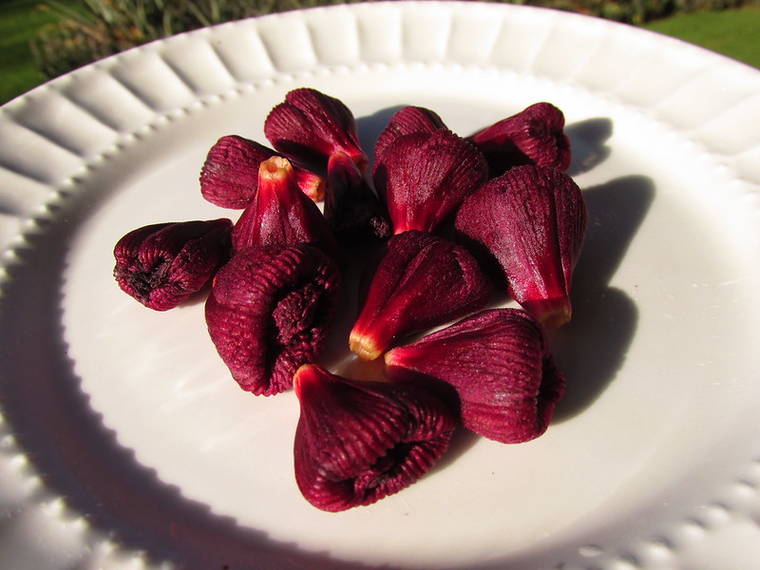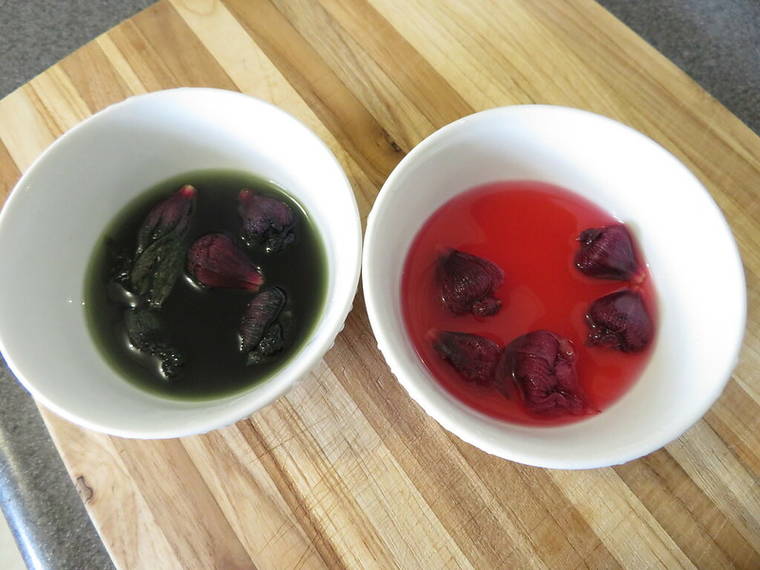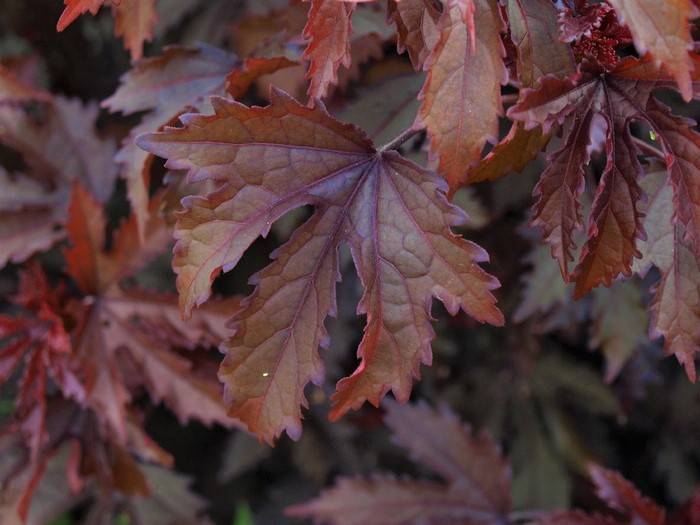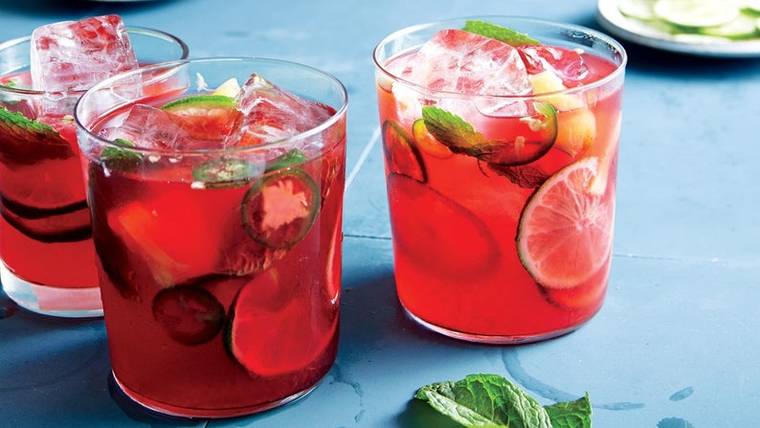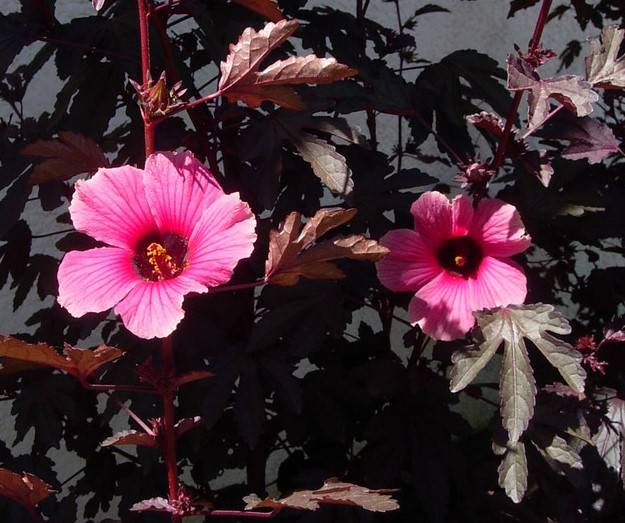Not many of us here in Kona need to use fireplaces for warmth during our winter, but with the current chill in the air, a touch of fire might be a welcome addition to our gardens. We have a few red plants to consider. Some ti plants, the copper bush and a few croton varieties as well as the Japanese maple tree all have red leaves. The “Mahogany Splendor” hibiscus not only has deep burgundy leaves but also bears a velvety red hibiscus flower. Easy to grow and a lovely addition to a landscape, this red-leafed hibiscus makes a warm addition to a late winter garden.
The wonderfully rich red hibiscus (Hibiscus acetosella) is a member of the large hibiscus genus, that includes several hundred species in the malvacea or mallow family. All grow best in warm climates and are mostly grown for their attractive flowers.
Likely native to the Congo-Angola-Zambia region of Africa, the red-leafed hibiscus was popular in African villages as both an edible and medicinal plant. It was later brought to Brazil and Southeast Asia where its leaves continue to be used as a raw or cooked vegetable in salads and stir fries.
The “Mahogany Splendor” hibiscus was first recognized as a distinct species in 1896 by French botanists and given the botanical name acetosella. The word acetosella is actually derived from the old Latin name for the sorrel plant which is similarly sour in taste. Sometimes H. acetosella is known by the common name cranberry hibiscus, because of the tasty sour tartness of the leaves.
“Mahogany Splendor” is grown here for its stunning beauty as a plant and because its leaves and flowers are edible herbs. They are often used to make a lemony pink tisane that mixes well with other juices or can be consumed alone or made into a tasty jelly. The flowers can be used when open or just closed and still fleshy. They soon dry into a pointed calyx, so are best harvested during or just after blooming.
Unlike many deeply colored leaves, those of “Mahogany Splendor” retain their color when cooked as a vegetable. Their ability to hold their color makes it possible to use the leaves and the flowers to make dyes.
This red-leafed hibiscus is a fast growing perennial shrub here in Hawaii. It can grow to nearly 6 feet and 3 feet wide in a single season under ideal conditions. The deeply lobed mahogany leaves can be almost 4 inches across, have serrated edges and are similar in appearance to those of the Japanese maple. The flowers are usually a very deep red though some species produce a pink flower with red veins.
The flowers only last a single day, usually opening early in the morning and closing by noon. The blooms open toward the end of a branch opening successively leaving behind a deep red pointed calyx. The sturdy branches with red their leaves, flowers and series of dried calyx are often used to add interest and color to floral arrangements.
Though Hibiscus acetosella can be grown in groups as a hedging plant, it can also serve singly as a specimen plant adding color and texture to your garden. Though it is neither wind nor salt tolerant, it is a vigorous, drought and heat-tolerant plant that also grows well in containers.
It grows best in full sun. In shady locations, it will grow well but the foliage will likely lose the red brilliance that full sun encourages. This hibiscus likes a moist, slightly acid soil of between pH 5.8 and 6.5. .
Propagating “Mahogany Splendor” is fairly simple. It can be done from cuttings or seeds. To start from seeds, collect them from the dried calyx that appears on the stem following (and below) the flowers. The seeds should shake out easily. To hasten germination you can soak the seeds overnight in warm water then nick them with a razor blade before sowing.
Sow the seeds in small pots or seedling trays using a potting mix that drains well. Cover the seed lightly and keep the medium moist, but not wet. Viable seeds should germinate within two weeks.
Once the seedlings have several sets of true leaves, the young plants can be moved to larger pots or to a protected place in the garden and get light fertilization. Introduce them to full sun gradually over several days before planting out.
For vegetative propagation, take cuttings from branch ends 4 to 6 inches long. Dip them in a rooting compound and then place them in a medium that drains well. A 50/50 mix of perlite and vermiculite works well. Once they start putting out new leaves you can treat them like seedlings.
With adequate water and a location in full sun, “Mahogany Splendor” needs almost no care to keep it happy. You can prune to control size and shape and to preserve its bushy growth habit. Keeping this hibiscus fairly compact will encourage flowering and help maintain its attractive appearance. Regular fertilization is also recommended. Applying a balanced fertilizer three or four times a year should be adequate.
Though it may be occasionally attacked by insects like Chinese rose beetle or white fly, lox tox remedies are usually adequate to control them. Overall, keeping your plant healthy will discourage insect or disease attacks.
Red-leaved hibiscus plants can be found at some local nurseries or requested through Margo Lundstrom (formerly of Sunrise Nursery) at 640-9191. If you know someone who has a plant, you can also ask for a cutting and grow your own.
Seeking a Hibiscus acetosella plant for your garden will be time well spent. It will be a warm textural and colorful complement to your garden as well as adding some interesting accents to your food and drink. Once they start blooming, they will offer a chance for a special morning experience in your garden to see the flowers in their full open beauty.
Diana Duff is a plant adviser, educator and consultant living part time in Kailua-Kona.
Gardening Events
Saturday: “Work Day at Amy Greenwell Garden” from 9 a.m. to 12:30 p.m. Meet at the Garden Visitor Center across from the Manago Hotel in Captain Cook. Volunteers will be able to help with garden maintenance and are invited to bring a brown bag lunch. Water and snacks provided. Call Peter at 323-3318 for more information.
Farmer Direct Markets
Wednesday: “Ho’oulu Farmers Market” 9 a.m. to 2 p.m. at Sheraton Kona Resort &Spa at Keauhou Bay
Saturday: “Keauhou Farmers Market” 8 a.m. to noon at Keauhou Shopping Center
“Kamuela Farmer’s Market” from 7:30 a.m. to 1 p.m. at Pukalani Stables
“Waimea Town Market” from 7:30 a.m. to noon at the Parker School in central Waimea
“Waimea Homestead Farmers Market” from 7 a.m. to noon next to Thelma Parker Gym in front of Thelma Parker Library.
Sunday: “Pure Kona Green Market” 9 a.m. – 2 p.m. at Amy Greenwell Garden in Captain Cook
“Hamakua Harvest” 9 a.m. to 2 p.m. at Hwy 19 and Mamane Street in Honoka’a
Plant Advice Lines
Anytime: konamg@ctahr.hawaii.edu Tuesdays &Thursdays: 9 a.m. to noon at UH-CES in Kainaliu – 322-4892
Mon., Tues. &Fri: 9 a.m. to noon at UH CES at Komohana in Hilo 981-5199 or himga@hawaii.edu
Photos:









